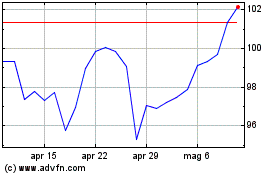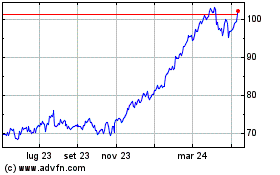The Hartford’s Future of Benefits Study: Generational Perspectives On The Workplace From Boomers to Zoomers
13 Giugno 2024 - 3:02PM
Business Wire
- Despite higher levels of burnout and disproportionate mental
health challenges, Generation Z workers are most likely to value
connections with coworkers and feel optimistic about their
financial futures
- Amid a surge of new responsibilities, employers are doing their
best to meet the needs of their employees, but challenges
remain
The Hartford’s fifth annual Future of Benefits Study, released
today, reveals different generational perspectives about workplace
productivity, employee benefits, personal finances, mental health,
and paid leave as more Gen Z workers (zoomers) enter the workforce
and many baby boomers retire. Gen Z experiences higher levels of
burnout and disproportionate mental health challenges compared with
other generations, yet is most likely to value connections with
coworkers and feel optimistic about their financial futures.
“The expectations and needs of Gen Z workers across many facets
of the workplace are notably different from other generations,”
said Jonathan Bennett, head of Group Benefits at The Hartford. “As
the number of next-generation employees surpasses baby boomers in
the workplace, understanding these differences and taking a
multigenerational approach to workplace benefits is crucial to
shaping the future of work.”
Key findings include:
- 3-in-5 U.S. workers are experiencing some level of burnout at
work, with Gen Z more likely to say they always/often experience it
(32%) compared with other generations.
- 29% of U.S. workers report feeling depressed or anxious at
least a few times a week, yet stigma prevents them from seeking
mental health care (39%), which is more significant among Gen Z
workers (45% and 52%).
- Gen Z workers are more likely to report that their financial
health (47%), mental health (41%) and physical health (38%)
negatively impacts their productivity.
- Gen Z workers (75%) say strong personal connections at work are
important compared with millennials (70%), Gen X (67%) and baby
boomers (62%).
- 53% of Gen Z workers believe their financial situation will get
better in the next year compared with millennials (45%), Gen X
(32%) and baby boomers (26%).
“It is encouraging to see Gen Z’s optimistic financial outlook,
although there’s more we can do to help employers support financial
and mental health in the workplace,” Bennett added. “As an employee
benefits provider, The Hartford is focused on helping our employer
clients reach all generations with simple benefits education to
increase understanding about how the benefits they are offered in
the workplace can help support employee wellbeing, protect their
paychecks and provide a financial safety net.”
Keeping pace with employee needs and technology
The generational shift is increasing the complexity for
employers who are holistically seeking to address the evolving
needs of their employees. Employers are also faced with a surge in
new responsibilities and a need to keep up with rapidly changing
technology.
The Hartford’s 2024 Future of Benefits Study, which polled U.S.
workers and HR professionals (employers), found 62% of employers
said their day-to-day responsibilities have increased in the past
few years. In addition, 84% say advances in HR technology have
expanded their responsibilities and required them to develop new
skills. While balancing the shifts in their responsibilities,
employers still face challenges with managing benefits, employee
expectations and benefits education.
Over the past five years, the study has shown that U.S. workers
consistently value the benefits offered to them. However, employers
believe employees underutilize employee benefits. Some U.S.
workers, particularly Gen Z and millennials, admit they don’t fully
understand the voluntary or supplemental benefits offered in the
workplace and are seeking better resources to enhance their
understanding.
Key findings include:
- 50% of U.S workers believe their company needs better resources
to help them understand their benefits.
- 73% of employers believe employees underutilize the benefits
and services available; this has increased significantly since
March 2020 (64%).
- 67% of employers say educating employees about benefits is a
challenge, which has been an ongoing concern over the past five
years.
- 80% of U.S. workers value the insurance benefits their company
offers to them, which is flat compared with March 2020.
- 38% of U.S. workers do not understand supplemental benefits and
what they cover.
A spotlight on paid leave
Paid family and medical leave are benefits sought after by all
generations in the workplace and can help people of all ages take
care of themselves or their loved ones. It is one area of benefits
that employers continue to expand, and workers believe can help
attract and retain employees. However, many U.S. workers,
especially Gen Z, consistently express concerns about taking a
leave of absence from work. The complexity of managing leave for
employers continues to increase as more states implement paid
family and medical leave programs.
Key findings include:
- Employers have added or expanded leave benefits beyond state or
federal requirements, including:
- Medical leave: 46%
- Sick time: 46%
- Paid time off (PTO)/vacation time: 39%
- Family leave: 38%
- Parental leave: 38%
- Half of employers say there is no easy way to track and manage
all of the leave types.
- 33% of U.S. workers think there is a negative perception
associated with taking leave.
- 34% of U.S. workers are fearful of workplace repercussions if
they take a leave, an increase from 29% in 2023 and highest among
Gen Z (49%).
The Hartford is a leading provider of employee benefits and
absence management. For more information about the company’s Group
Benefits offerings, visit www.thehartford.com/groupbenefits. For
more information about The Hartford’s 2024 Future of Benefits
study, visit www.thehartford.com/futureofbenefits.
Study Methodology
The Hartford’s 2024 Future of Benefits Study was fielded Feb. 21
– March 4, 2024 and included 502 employers and 1,246 U.S. workers.
The employers surveyed were HR professionals who manage/decide
employee benefits and U.S. workers surveyed were actively employed.
The margin of error is employer +/- 4% and U.S. worker +/-3% at a
95% confidence level.
About The Hartford
The Hartford is a leader in property and casualty insurance,
group benefits and mutual funds. With more than 200 years of
expertise, The Hartford is widely recognized for its service
excellence, sustainability practices, trust and integrity. More
information on the company and its financial performance is
available at https://www.thehartford.com.
The Hartford Financial Services Group, Inc., (NYSE: HIG)
operates through its subsidiaries under the brand name, The
Hartford, and is headquartered in Hartford, Connecticut. For
additional details, please read The Hartford’s legal notice.
HIG-E
Some of the statements in this release may be considered
forward-looking statements as defined in the Private Securities
Litigation Reform Act of 1995. We caution investors that these
forward-looking statements are not guarantees of future
performance, and actual results may differ materially. Investors
should consider the important risks and uncertainties that may
cause actual results to differ. These important risks and
uncertainties include those discussed in our 2023 Annual Report on
Form 10-K, subsequent Quarterly Reports on Forms 10-Q, and the
other filings we make with the Securities and Exchange Commission.
We assume no obligation to update this release, which speaks as of
the date issued.
From time to time, The Hartford may use its website and/or
social media channels to disseminate material company information.
Financial and other important information regarding The Hartford is
routinely accessible through and posted on our website at
https://ir.thehartford.com. In addition, you may automatically
receive email alerts and other information about The Hartford when
you enroll your email address by visiting the “Email Alerts”
section at https://ir.thehartford.com.
View source
version on businesswire.com: https://www.businesswire.com/news/home/20240612734632/en/
Michelle Symington michelle.symington@thehartford.com
Grafico Azioni Hartford Financial Servi... (NYSE:HIG)
Storico
Da Dic 2024 a Gen 2025

Grafico Azioni Hartford Financial Servi... (NYSE:HIG)
Storico
Da Gen 2024 a Gen 2025
